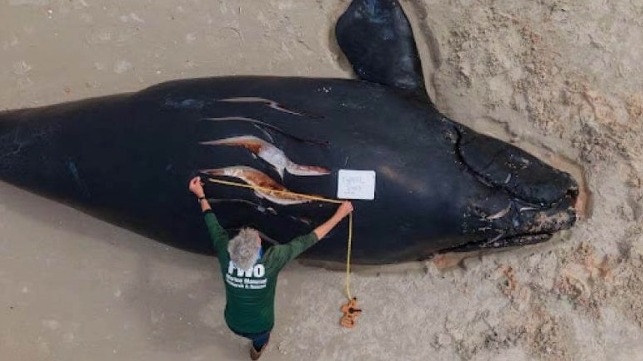Right Whale Speed Limits for Ships May Be Applied to Small Craft

NOAA's National Marine Fisheries Service is reviewing its seasonal East Coast speed limits for protection of the North Atlantic right whale, but not quickly enough for environmental activists, who argue that this endangered species needs faster protection from speeding small craft.
The Center for Biological Diversity and its partners have petitioned NMFS to immediately adopt its own internal proposal for expanded speed regulations, including applying a 10-knot seasonal speed limit to vessels under 65 feet and enlarging seasonal protection areas. The Center has also called on NMFS to require compliance with the shifting, "dynamic" low-speed zones implemented around whale sightings in calving areas.
The Center argues that expanded regulations would help prevent serious whale strikes, like a boat collision that killed a calf and may have killed its mother off Florida last year. That collision also destroyed the vessel, costing the owner and insurer about $1.2 million.
“A newborn calf spends most of its first few months of its life on the surface with its mother,” said Erica Fuller, senior attorney at Conservation Law Foundation. “Given that these whales are tough to see under the best of circumstances, slowing boats down is the only way to prevent collisions like those that have killed whales, injured people and caused major vessel damage in the past.”
NMFS recently released a study of vessel speed patterns and whale-protection rules off the U.S. East Coast, and it found that pleasure vessels and passenger vessels were the least compliant vessel class - and "highly non-compliant" in the region from North Carolina south to Florida. The coastal waters of the U.S. Southeast are home to the only known calving area for North Atlantic right whales.
For vessels under 65 feet, the rules do not currently apply. NMFS found that this could be a problem: Over half of small pleasure vessel traffic in the seasonal management area is over 10 knots, and that number rises to 85 percent for small but speedy pilot boats.
Most documented right whale collisions involve small craft, and even minor injuries may have cumulative health effects, according to the Center.
Conservationists say that the species' survival now comes down to the fate of each individual, since so few are left. Scientists at the New England Aquarium recently determined that only 340 North Atlantic right whales remain, with about 70 reproductive females. The math is unfavorable: each mother gives birth only once every three to ten years, and human-caused deaths from vessel strikes and lobster pot entanglements amount to an estimated 30 whales per year. Scientists estimate that functional extinction could occur by 2040.
"It is hard to think of a conservation situation more deserving of emergency action, particularly given the unique vulnerability of right whale mothers and calves to vessel strikes and the overwhelming information demonstrating that slowing vessels down protects right whales from deadly collisions," argues the Center.
